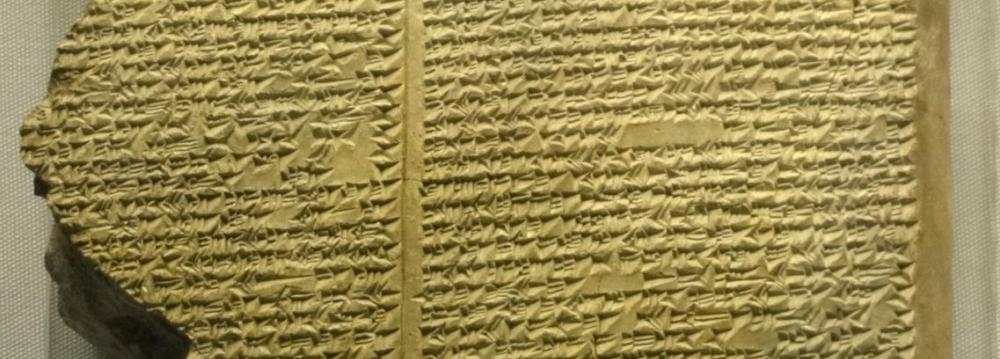The cruel irony in the literary heritage of Iraq is that as far back as the 12th century BC, the region was a paradise for rivaling scholars and scribes, as well as for the apprentices assigned to duplicate literary texts.
The cultural heritage of Mesopotamia over the centuries concentrated in Nineveh, the suburb of the modern day northern city of Mosul. The royal library of Nineveh was founded by Shalmaneser in the 9th century BC. His successor, the last strong king of the Neo-Assyrian Empire Ashurbanipal, almost doubled the collection in the 7th century BC, thus the library is known as the Ashurbanipal library, according to the British Museum website.
The library contained over 10,000 texts flat bricks or tablets, recording history, laws, rituals, and literary treasures. An almost complete list of ancient Near Eastern rulers was preserved in the Ashurbanipal palace library at Nineveh.
The oldest extant Akkadian documents were among the library’s assets. The original library documents however, which would have included leather scrolls, wax boards, and possibly papyri, contained perhaps a much broader spectrum of knowledge than that known from the surviving clay tablet cuneiform texts.
Ashurbanipal’s library is not the first library of its kind but is among the largest surviving to the present day. Most of it is now in the possession of the British Museum or the Iraq Department of Antiquities.
1st Assault: Fire
In 612 BC, a coalition of Babylonians, Sagartians, and Medes attacked Nineveh and burned Ashurbanipal’s palace. A great fire must have ravaged the library, causing the clay cuneiform tablets to become partially baked.
Paradoxically, this potentially destructive event helped preserve the tablets. The fired clays survived 2,500 years under a heap of ruins.
Overtime Nineveh was replaced by Mosul across the Tigris on the western bank, and the Kuyunjik mound, where the Neo-Assyrian tablets remained was absorbed into the Mosul metropolitan area.
2nd Assault: Water
In 1258 AD, Mongols ransacked Baghdad. They looted and then destroyed mosques, palaces, libraries, and hospitals.
The Grand Library of Baghdad, containing countless precious historical documents and books on subjects ranging from medicine to astronomy was destroyed by Hulagu’s army.
Survivors said that the waters of the Tigris ran black with ink from the enormous quantities of books flung into the river and red from the blood of the scientists and philosophers killed.
3rd Assault: Looting
In April of 2003, when combined forces of the US, UK, Australia, and Poland deposed the Ba’athist government of Saddam Hussein, the National Library and Archives which was located directly across from the ministry of defense in Baghdad, was burned and looted.
According to the director general of the national library Saad Eskandar, three days before the invasion, library staff were told to destroy all archival material related to Ba’athist rule. Eskander also reported that the destruction was performed by a mix of poor people looking for a quick profit, along with regime loyalists intent on destroying evidence of atrocities.
The National Library lost about 95% of its rare books, 60% of the archival collections, and 25% of the book collection.
4th Assault: Purge
One afternoon in January 2015, Islamic State militants raided the Central Library of Mosul. They removed thousands of volumes on philosophy, science, and law, along with books of poetry and children’s stories.
Maps and books from the Ottoman Empire were among the collection which was loaded in six trucks and taken to unknown destination.
When Baghdad’s central library was looted and destroyed, nearby residents hid some of its centuries old manuscripts in their homes to prevent their theft and destruction. But this time, IS group warned against such attempts, announcing that the penalty would be death.
Days later, IS militants broke into the University of Mosul’s library, piled up hundreds of books on science and culture, and set fire to them, creating a bonfire in front of shocked students.
The IS group started wrecking other public libraries, including the archives of a Sunni Muslim library, the library of the 265-year-old Latin Church, Monastery of the Dominican fathers, and Mosul Museum Library which used to house ancient works.
As columnist of the Boston Globe Jeff Jacoby puts it, perhaps the most chilling words ever written about book-burning were penned in 1821 by German poet Heinrich Heine: Dort wo man Bücher verbrennt, verbrennt man am Ende auch Menschen – “Where they burn books, they will in the end burn people.” Today that axiom is etched on a plaque in Berlin’s Bebelplatz, the public square where more than 20,000 books deemed “un-German” and “decadent” were destroyed in a vast Nazi bonfire on the night of May 10, 1933.


